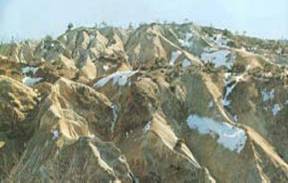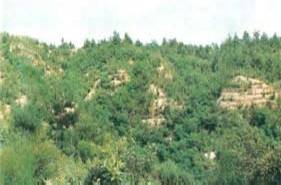The Republic of Korea
History and Present Situation of Sabo (Erosion Control) in the Republic of Korea
1. Cause of Devastation of Forest Land
With regard to the overall climate in the Republic of Korea, both the annual average precipitation and annual average temperature are slightly lower than those in Japan. In the meantime, precipitation concentrates on the period from June to September due to the rainy season and typhoons, and winter is a dry season. The forest area accounts for approx. 65% of the entire country, and the base rock of the forest lands mainly consists of granite and granite gneiss, which are subject to landslide and erosion. The precipitous terrain and concentrated heavy rains are also the causes of landslide. Because of geologically, geographically, and meteorologically disadvantages, there used to be a lot of devastated forest lands all over the country.
There were also biological factors, such as disease and insect damage, and human factors, such as overharvesting, in the past. Since the 1970s, however, such devastated lands have been recovered by the reforestation projects, which worked out by the government.
2. History and Present Situation of Sabo in the Republic of Korea
In 1907, the government started its first sabo project in the suburbs of Seoul. For the purpose of improving landscape, “terracing with sods” and “terracing with plants” were made around the area near Changuimun, and this project was the first sabo works in the Republic of Korea. These works were called the “sabo works at Niou mountain range” or the “sabo works at Bukhan Mountain range,” and these works were continued for more than 20 years since the project started. The stone-built facilities built in the mountain range of Mt. Bukhan, Mt. Dobong, and Mt. Gwanak still retain their functions today.

Strong sea wind caused to severe devastation in Uljin regions (1989).

The devastated forest lands were miraculously restored after three years of construction.
From 1918, sabo works were conducted at the basin of Geum-gang, Nakdong-gang, and Seomjin-gang for the purpose of protecting their water source.
From 1922 through 1947, the sabo project was conducted for those who suffered from poverty, floods, and long-lasting droughts. In fact, thanks to the sabo project, the devastated mountain ranges were gradually recovered. During the Korean War in 1950, however, severe illegal logging and collection of fuel woods were extensively conducted. This excessive logging further accelerated the devastation of the forest area. Consequently, the Forest Land Protection Temporary Measures Law was established, but no conspicuous recovery was achieved.
In 1952, village forestry cooperatives at the local level were organized. Since 1954, on a nationwide basis, the government has subsidized the budget required for sabo works at the local level, making a huge contribution to planting of devastated forest lands. As part of this government policy, wheat flour which was donated by UNKRA (United Nations Korean Reconstruction Agency) was supplied to war victims of the Korean War in compensation for their labor for the recovery works for the devastated lands.
In 1955, gully control works were also conducted with the support of ICA (International Cooperation Administration). In 1961, the first “forest land law” was established. On January 15, 1962, the “sabo law” was established, with the legislation number 977, under the forest land law.
The “forest planting promotion temporary measures law” was also established in 1963. These legislative measures made the sabo project one of the major forest policies and prompted citizens to actively take part in the sabo project.
Erosion control works have been promoted as one of the main fields of the national reconstruction project, and approx. 80% of the total budget of Ministry of Forest were spent on the sabo projects. As the result, in 1963, the hillside sabo works for approx. 180,000 ha were completed.
In 1973, the primary 10-year reforestation project (1973 – 1982) was started, and the mountain sabo of 82,268 ha, seaside sabo of 952 ha, and gully sabo of 500 km were planned. The basic purpose of these plans was to define a systematic procedure and priority of reforestation and complete the sabo works. The systematic procedure and priority for this reforestation were defined by measure works according to the damage types, such as mountain sabo, gully sabo, and seaside sabo in the areas which are highly likely to be devastated and the extremely devastated areas.
It was determined that those who created the cause of the devastation of the areas which have been devastated by human activities would bear the responsibility for the reconstruction of the areas, and for other areas, the government policies would be carried out in accordance with the land register and map. For the areas to which measures had been taken, a special care was taken as follow-up management.

Wasting state by erosion activities in the torrent streams.
Construction by keeping the natural shapes in the torrents and scenic beauty in the natural stone stacking could be contributed to the access of the recreation visitors.
In 1979, the secondary 10-year reforestation project (1979 – 1988) was started, and the
mountain sabo of 78,268 ha, seaside sabo of 400 ha, and gully sabo of 3,300 km were
planned.
Approx. 20% of the sabo works were linked up with Saemaul Undong and carried out
through contract agreements with village people to increase the farmers’ income.
The gully sabo works, which had been suspended since 1977, was resumed in 1984.
The construction of sabo dams was started in 1986 as a new project.
In 1988, the third 10-year reforestation project (1988 – 1997) was started. The
mountain sabo of 4,710 ha, prevention sabo of 1,300 ha, seaside sabo of 12 ha, gully sabo
of 2,410 km, and 1,300 sabo dams were planned, and these works were carried out.
Since 1988, the prevention sabo has been added and applied to the areas susceptible to
devastation.
The sabo related projects have been carried out under the direct control of the
government for last 86 years because the work sites were apart from each other in steep
terrain.
In 1993, contract construction was adopted because of the completion of the mountain
sabo and the change of the work conditions, such as shortage of local labor forces and
insufficient mechanical automation. On March 24, 1994, an overall revision of the “sabo
project law” was made to improve the effectiveness of the contract system and amend the
basic conditions of mechanical automation of the sabo works.